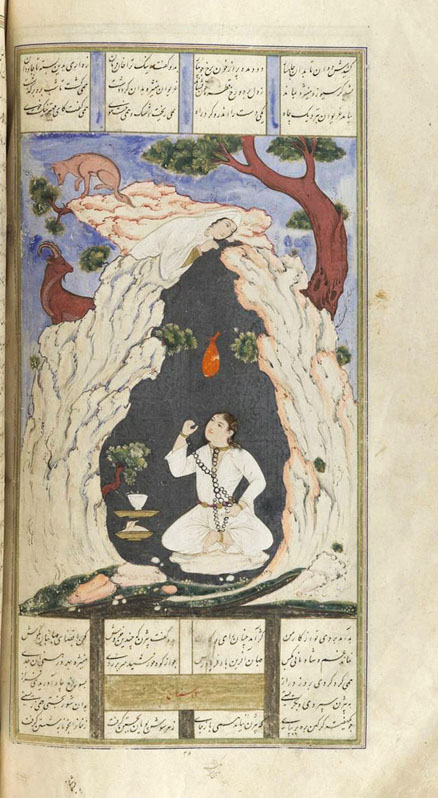Maniža Feeds Bižan
The subject is not a common one in the episode of Bižan in the Pit, and compositionally parallels closely the more typical illustration of the rescue of Bižan shown on folio 184. Maniža is shown here lowering a pouch on a string through a narrow orifice at the top. The pit, a hollowed out “hill” rather than a hole going below ground, is roughly oval in shape, and shown in a peculiar cross-section as if the front half has been removed, permitting one to view inside. True to the narrative, Bižan, with chains shackling his hands and feet to his neck, sits cross-legged at the bottom. But the Bižan portrayed hardly gives the appearance of being incarcerated: well groomed, with youthful almost effeminate features, wearing fresh white clothing, vessels of food and drink at his side, and chains so slack that they hardly seem an impediment to his movements. The walls of the pit are coral-like craggy rock that curve inward to form a narrow opening at the top. Under close scrutiny many of these craggy tips form minute grotesque faces, a device dating back to at least the sixteenth century. Maniža, dressed in a plain white shroud with only her face and right hand visible, peers through the opening and lowers a pouch to her lover below. The large boulder that blocks the entrance to the pit is in an ambiguous spatial position behind Maniža, appearing more like a continuation of the walls than an impediment to the entrance. There are no other participants except for a jackal and a goat on the rocks in the upper left. A large tree trunk emerges from the rock formation in the upper right, and wisps of shrubbery grow at various junctures..
Painting: 23 x 16.5 cm. The text is written in four columns above and below the painting, with a rectangular frame enclosing painting and text. The miniscule signature raqam-e kamina fażl ʿali appears just above the neck of the jackal. In the lower margin, written in Moʿin’s hand, is the signature raqam-e kamina moʿin-e moṣavver. Attributed by Jackson and Yohannan to Fażl ʿAli, and by Robinson to Moʿin with the assistance of Fażl ¯Ali. The painting is in excellent Mo¯in style; the detailing indistinguishable from the master’s. Yet the Fażl ʿAli signature suggests that Moʿin had assistance.
Painting references:
J&Y_1914, pp.37, no.27 (not ill.).
Pavry, Heroines_1930, ill. opp. p.40.
Guest, AI_1943, p.151, fig.20.
Robinson, Cochran4_1972, pp.78-79, no.27 and p.83, fig.17.
Cambridge Shahnameh Project
Text references: Warner, III, pp.309-10; Mohl, IIII, p.264. Levy, p.165.
Robert Eng
Last Updated: February 9, 2011 | Originally published: June 18, 2003
